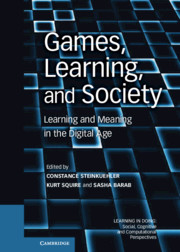Book contents
- Frontmatter
- Contents
- Contributors
- Series Foreword
- Foreword
- Acknowledgments
- Section I Games as Designed Experience
- 1 Introduction to Section I
- 2 Designed Cultures
- 3 Theme Is Not Meaning
- 4 Our Cheatin’ Hearts
- 5 Playing the Odds
- 6 Nurturing Lateral Leaps in Game Design
- 7 Uncharted 2: Among Thieves – How to Become a Hero
- 8 Interview with Harmonix
- 9 Yomi
- Section II Games as Emergent Culture
- Section III Games as Twenty-First-Century Curriculum
- Index
5 - Playing the Odds
Published online by Cambridge University Press: 05 August 2012
- Frontmatter
- Contents
- Contributors
- Series Foreword
- Foreword
- Acknowledgments
- Section I Games as Designed Experience
- 1 Introduction to Section I
- 2 Designed Cultures
- 3 Theme Is Not Meaning
- 4 Our Cheatin’ Hearts
- 5 Playing the Odds
- 6 Nurturing Lateral Leaps in Game Design
- 7 Uncharted 2: Among Thieves – How to Become a Hero
- 8 Interview with Harmonix
- 9 Yomi
- Section II Games as Emergent Culture
- Section III Games as Twenty-First-Century Curriculum
- Index
Summary
One of the most powerful tools a designer can use when developing games is probability, using random chance to determine the outcome of player actions or to build the environment in which play occurs. The use of luck, however, is not without its pitfalls, and designers should be aware of the tradeoffs involved – what chance can add to the experience and when it can be counterproductive.
Failing at Probability
One challenge with using randomness is that humans are notoriously poor at evaluating probability accurately. A common example is the gambler’s fallacy, which is the belief that odds will even out over time. If the roulette wheel comes up black five times in a row, players often believe that the odds of it coming up black again are quite small, even though clearly the streak makes no difference whatsoever. Conversely, people also see streaks where none actually exist – the shooter with a “hot hand” in basketball, for example, is a myth. Studies show that, if anything, a successful shot actually predicts a subsequent miss.
- Type
- Chapter
- Information
- Games, Learning, and SocietyLearning and Meaning in the Digital Age, pp. 44 - 48Publisher: Cambridge University PressPrint publication year: 2012



